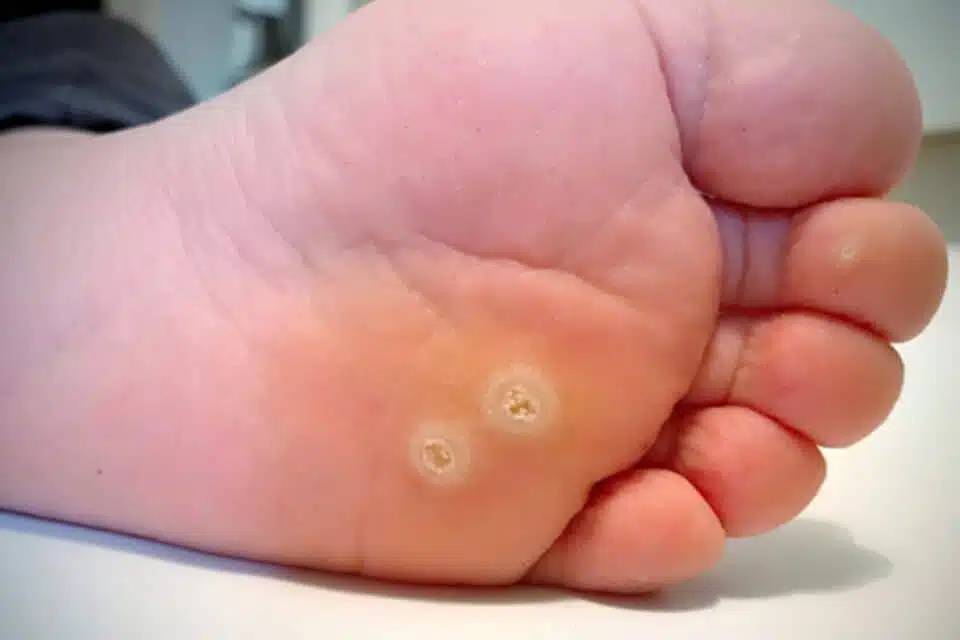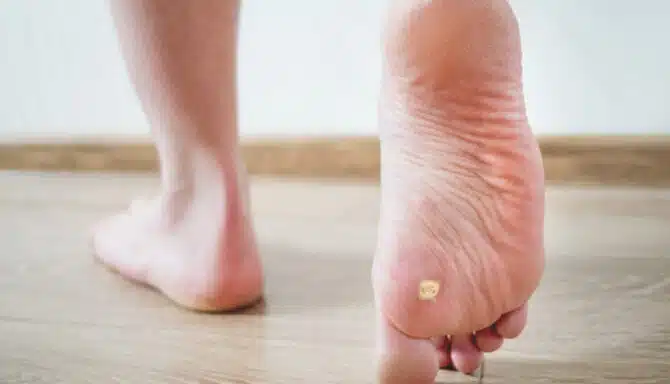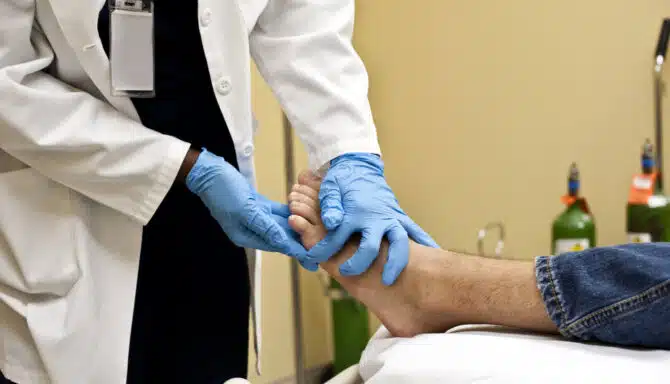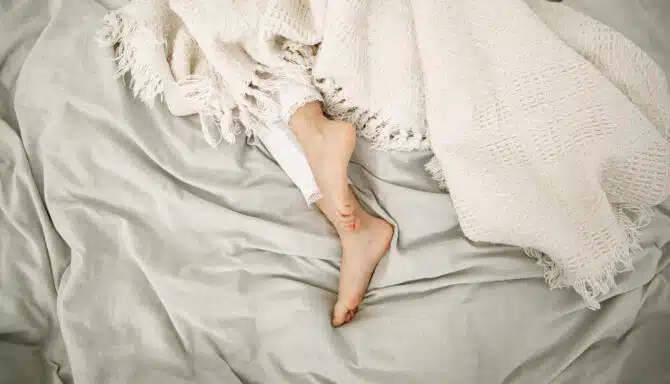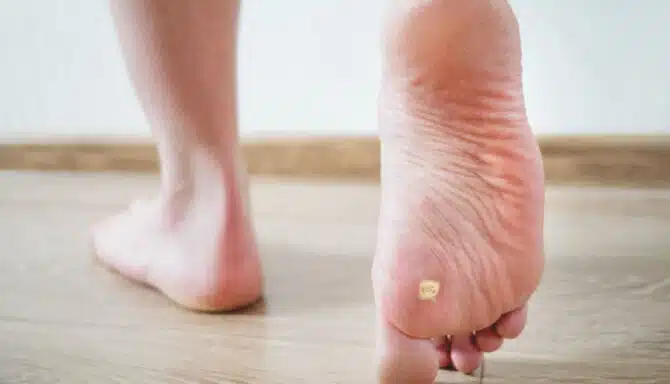Warts can occur anywhere on your body. These small, circular growths are a type of skin infection that stand out because of their roughness, slight discolouration, and sometimes even pain. When it comes to your feet, the soles are a common place for warts. This skin condition is known as plantar warts.
Although foot warts are a common occurrence, this condition comes with very treatable solutions. From self-care remedies to visiting a foot specialist, the scale of treatment methods varies based on the persistence level of warts. If you’re looking to avoid plantar warts altogether, learn about what causes them, or how to treat them, you’ve come to the right place.
In this article, we explore plantar warts, their causes, how to treat foot warts, and finally how to book an appointment with a foot specialist if you have persistent plantar warts.
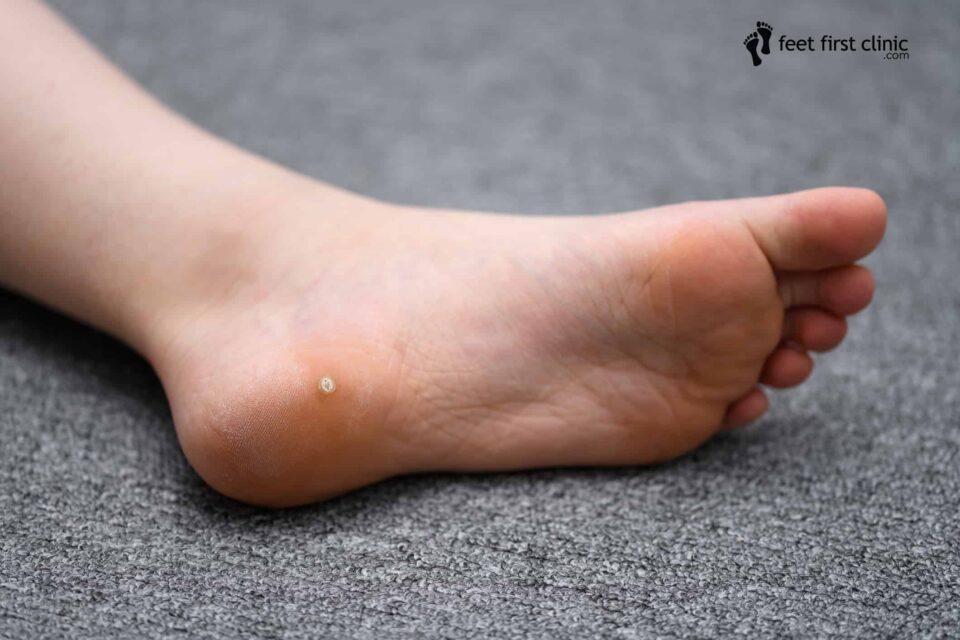
What are foot warts?
Plantar warts are common viral skin infections that can grow on any place on your foot. Usually the most common area is the bottom of the feet. They start out small, flat and look like a corn, callus or blister. Walking puts pressure on the wart causing a hard layer of skin to build up overtop. Applying pressure to plantar warts (walking, standing, or running) may be uncomfortable, if not painful.
Anyone can get plantar warts. They are not a severe health condition and sometimes go away on their own. However, they are contagious. If they persist, they can grow, spread and cause foot pain when you stand or walk on them.
What causes plantar warts?
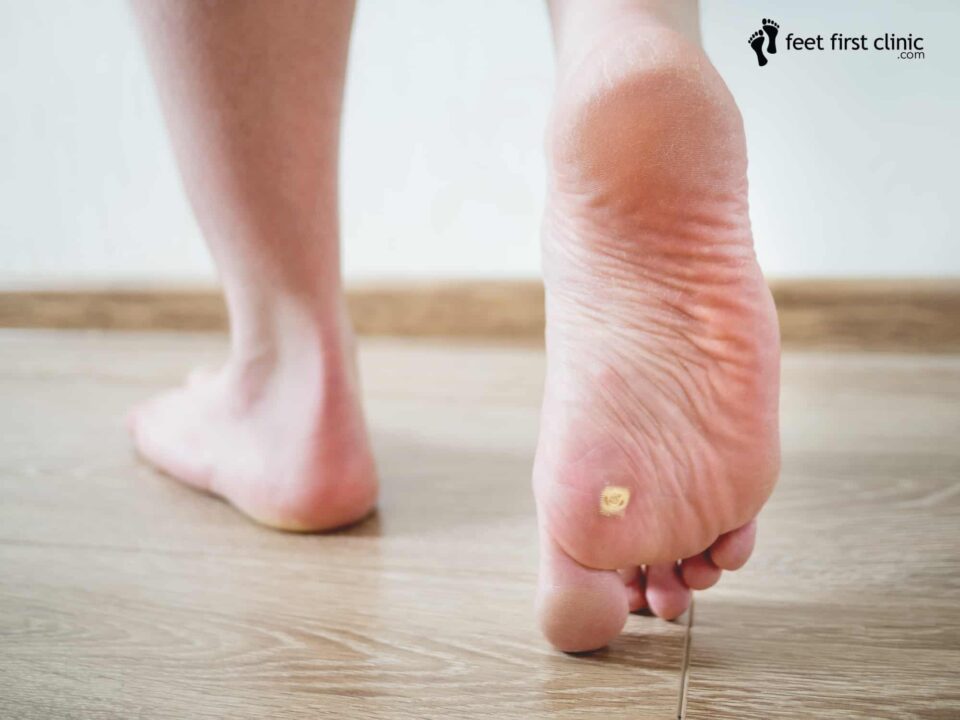
Human Papilloma Virus (HPV) causes foot warts by infecting the foot’s outer layer of skin. HPVs are a group of more than 200 related viruses. In the case of plantar warts, the strain of HPV causing this foot condition is not severe and varies from the strain that infects the reproductive tract. So, if you think plantar warts and herpes or genital warts are related, don’t worry – they’re not.
The virus can enter the foot by:
- A cut or perforation in the skin
- If the skin is too dry
- If the skin is too wet
- If you come into contact with a contaminated surface: Frequenting high-traffic common areas like showers, change rooms, and pool decks increase your likelihood of contracting the HPV that causes warts because the virus spreads more easily in these areas. Wearing sandals or flip-flops will help lessen your chances of catching warts by ensuring your bare feet do not come in contact with the virus that causes them.
- Children can be more prone to foot warts in part due to having sweaty feet
- As warts are caused by a virus, if you have a weakened immune system then you can be more susceptible to foot warts
Why Are Foot Warts Difficult To Treat?
The wart goes into your body’s skin cells. It uses those cells to manufacture more wart tissue. Your body doesn’t recognise it as foreign invador, as the wart is within your cells. As it grows the foot wart takes up nerves and small blood vessels. You might see black dots within a foot wart. These are called petechiae and are small burst blood vessels – not dirt.
So, what happens when you get plantar warts? Fortunately, there are several treatment options, including DIY methods as well as visiting a foot specialist.
But, please note: If you have low immunity, are prone to infection or have conditions that discourages “DIY treatments” (like Diabetes and Rheumatoid Arthritis) then you need to seek professional help to treat the warts.
It is also worthy to note that regardless of treatment, warts can come back. They are stubborn and usually multiple treatments are required to get the foot warts under control, especially if they are large.
8 Foot Wart Prevention Tips
Regardless of the treatment method you choose, it’s best to follow these practices:
- Cover the wart to help prevent it from spreading to either other people or another part of your body
- Wash your hands any time you touch the wart – accidentally or intentionally
- Do not pick the wart; you can transport it to your fingers
- Make sure other members of your household do not have foot warts
- Wash down the bath/ shower after each use
- Figure out why you caught the wart in the first place. If it’s a weekly swim, then wear footwear around the pool and in the communal showers. If your feet sweat, then try and reduce those sweating factors.
- If you are using over the counter treatments then gently dry buff the hard skin of the foot wart. This allows treatment to be more effective. However you should not use that file anywhere else.
- Replace the insole of your commonly used footwear so any wart tissue within your shoes is not going to reinfect you. If the insole is not removable, spray the inside of the shoe with a disinfectant spray that kills viruses (like Lysol disinfectant spray).
Sometimes (and rarely), plantar warts will get recognised by the body. It may take some years but they can go away by themselves. If that’s not the case, a foot specialist like a chiropodist can easily (and more quickly) remove plantar warts. There are also different treatments depending on how resistant the wart is to certain methods. For instance, if the wart is not responding to one treatment, a more aggressive treatment may be tried.
Below you’ll find a mix of at-home treatment methods and procedures done by a foot specialist at a local clinic:
Plantar warts treatments
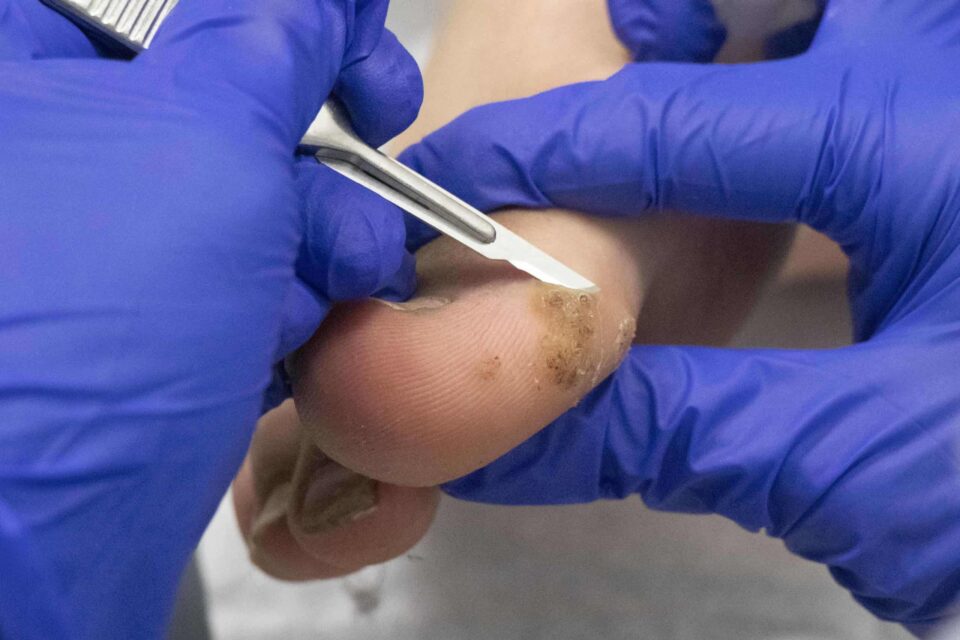
The most effective ways to treat foot warts are classed as either chemical or non chemical treatments.
Chemical
Blister-Inducing Medicine
A foot specialist can help induce a blister under the wart by applying cantharidin, a type of burn agent. This is applied every 2 to 3 weeks by a chiropodist. The cantharidin forms a blister over the wart, which separates the wart from the skin covering it and brings the wart to the surface. The blister then dries over the next few days and the wart falls off. The treatment is repeated until the wart is fully removed. Although the blister can be painful for a few days after treatment, cantharidin is considered more effective than other, less aggressive treatments – especially if you have stubborn persistent warts that don’t respond to more conservative treatments.
Cryotherapy
Cryotherapy is a method by which extreme cold is used to freeze and remove a plantar wart. Depending on the freezing solution, it can affect just the top layers of the wart or it can go down deep. Over the counter freezing solutions are not too strong and typically are only effective for very small and newly formed warts. Strong freezing comes in the form of liquid Nitrogen and is usually done in a clinical setting. It can be sore as it touches some of the nerves within the wart – it is also extremely cold. One of the main side effects is frozen blistering. Usually it goes in a day or two, but if it is sore or the blister persists then you should see your foot specialist.
Like cantharidin, cryotherapy requires repeat treatments every 2-3 weeks in order to be effective. It is not as aggressive as cantharidin, and therefore the wart typically takes longer to go away.
Salicylic Acid
Salicylic acid is a topical medication that is applied to the wart. It softens the skin and helps shed layers of skin (and the wart) bit by bit. It is found in many over-the-counter wart removal products, and a chiropodist can prescribe a high-strength salicylic acid topical solution that you can apply regularly at home. The higher the dose of salicylic acid, the better its treatment. You will see it working as the skin will turn white. Sometimes there is a slow build up, and then it rapidly affects the wart. While Salicylic Acid may be less painful than cyrotherapy or cantharidin, it takes much longer to treat the wart.
Salicylic acid can be painful if not properly washed off or managed properly. Your chiropodist will tell you how to properly manage this treatment.
Non-Chemical
Laser Treatment
Laser treatment involves cauterizing blood vessels. Ouch, that sounds intense. But, your medical practitioner will numb your skin first. To be effective, this treatment should be repeated every 2-4 weeks.
Needling
Needling is a simple, but more invasive wart removal procedure with roughly 70% effectiveness. After a local anesthetic is administered, a specialist punctures the wart with a sterile needle about 100 times. This method pushes the HPV away from the surface of the skin and further into your body, where an immune reaction is triggered. If successful, your body’s immune system will do the rest.
Excision
Excision is used for plantar warts that resist other treatments. The foot is first numbed with a local anesthetic. Then, as the name implies, the wart is cut away (or “excised”) from the skin. The base is also cauterized to ensure no living viral tissue is left behind. There is a risk of scarring, so this method isn’t used unless other treatments have failed.
Other “treatments” for foot warts you may have heard about
- Duct tape: Duct tape is a common yet relatively unproven method for treating plantar warts (largely because plantar warts can disappear on their own, which makes it difficult to attribute to the treatment method). This DIY method relies on constant use of duct tape and allowing the wart to get so wet and damp that it goes away. Very few people have had success because keeping the duct tape on for such a long time is very difficult. It is also not too hygienic; you’ll dampen the surrounding skin, which can cause other issues.
- Banana skins: There are supposedly enzymes within the actual skin of the banana that helps with wart treatments. Again, the success rate is extremely low.
- Apple Cider Vinegar: Success rate of this is extremely low.
- Salt water bathing: This doesn’t do anything apart from dry your feet out, which will actually make you a more prone to foot warts
- Rubbing a coin on the area: This method has been mentioned multiple times in internet forums; supposedly, the wart goes away in 1 day with this method. However, we’ve never seen this work and there is no scientific evidence that it does. For those that claim it does work, then it’s highly likely it wasn’t a wart in the first place.
Not only are the above “treatments” simply ineffective myths, they can waste precious time while your wart grows, spreads and multiples. At the end of the day, the best way to treat plantar warts is to see a foot specialist like a chiropodist at the first sign of any symptoms. The earlier you start treatment, the quicker and more effective it will be.
